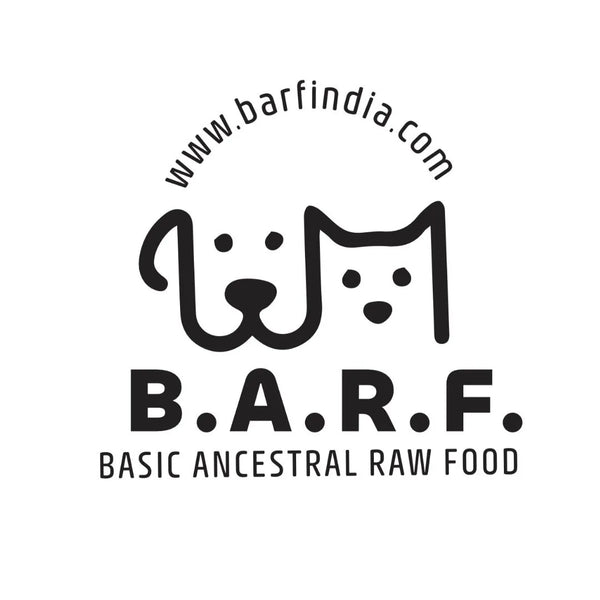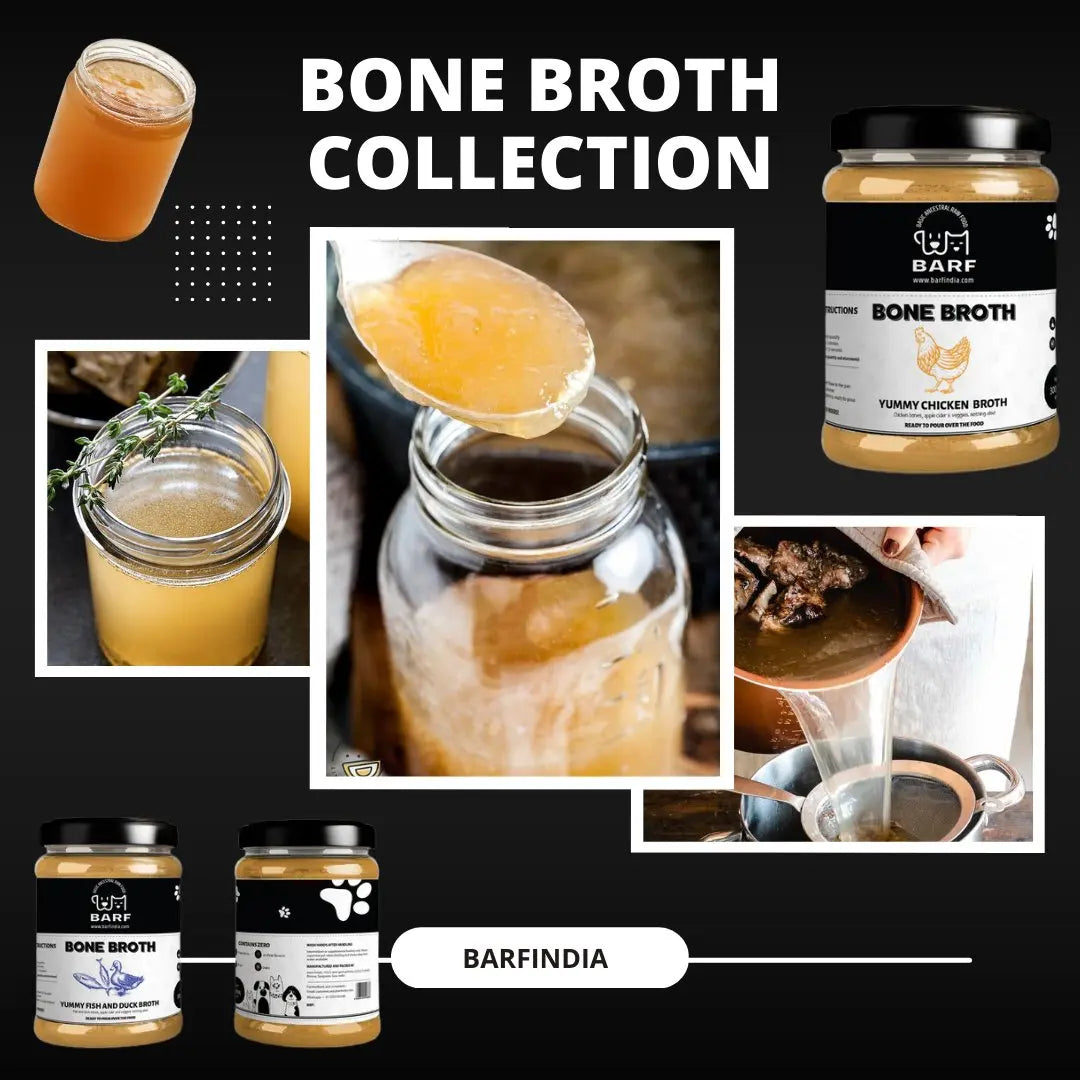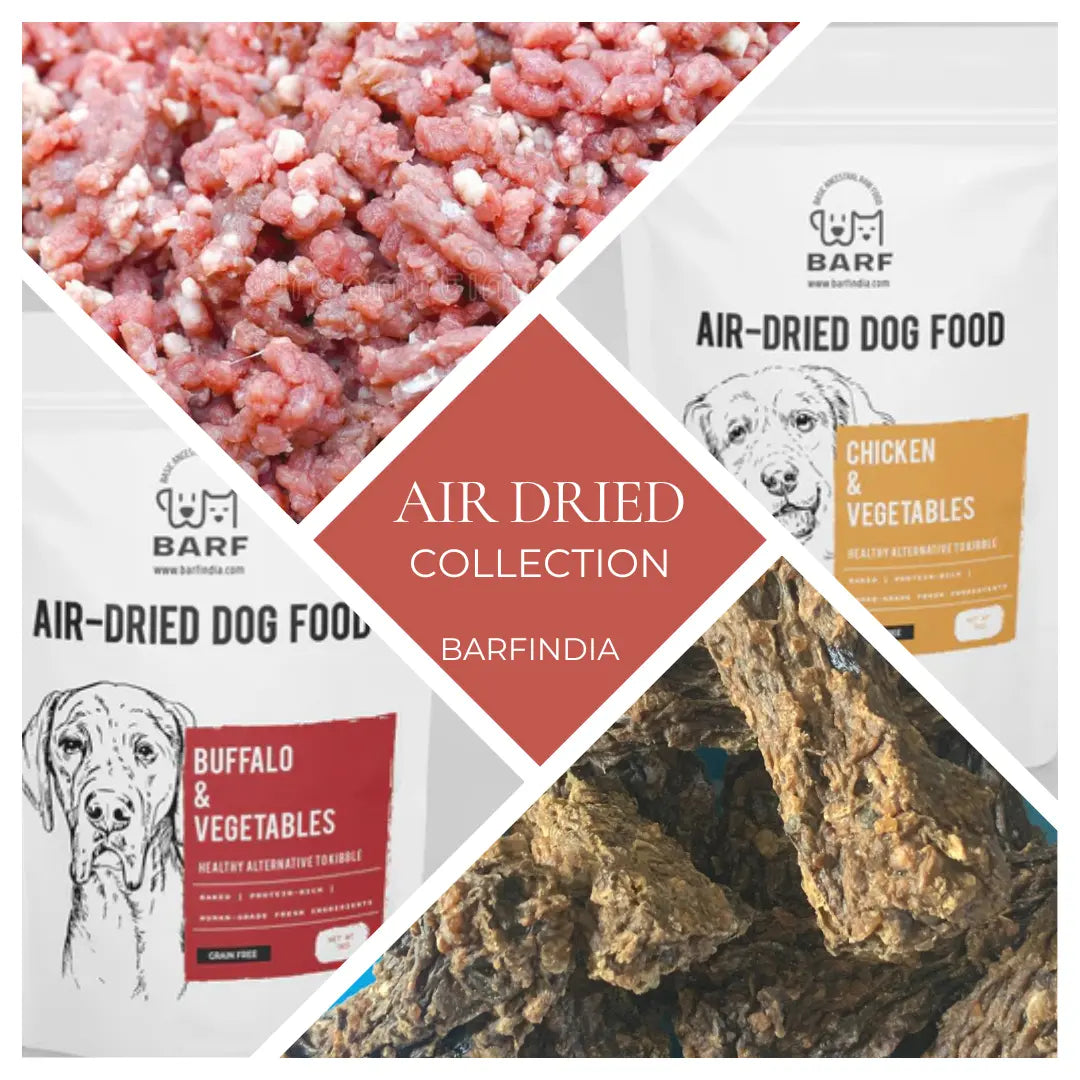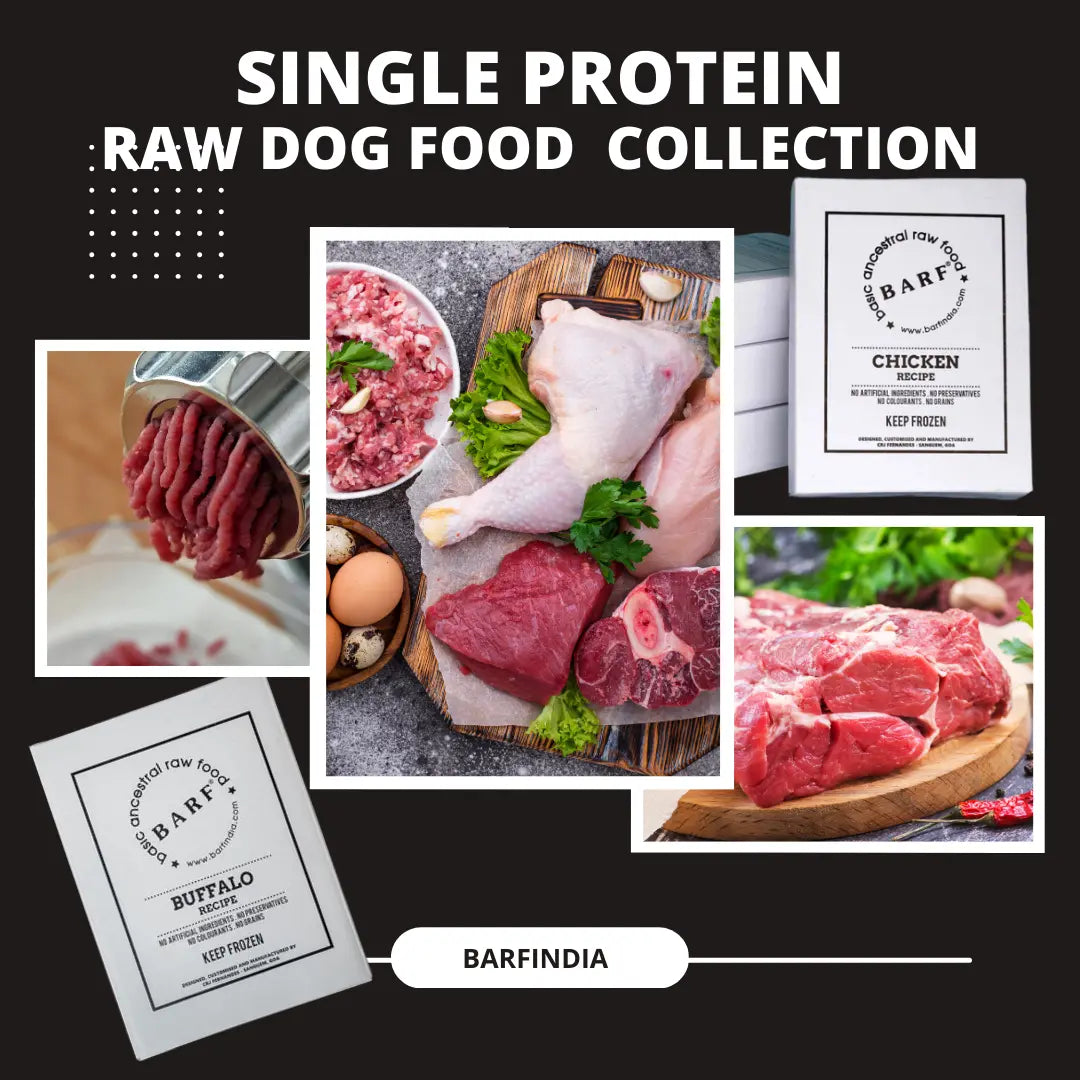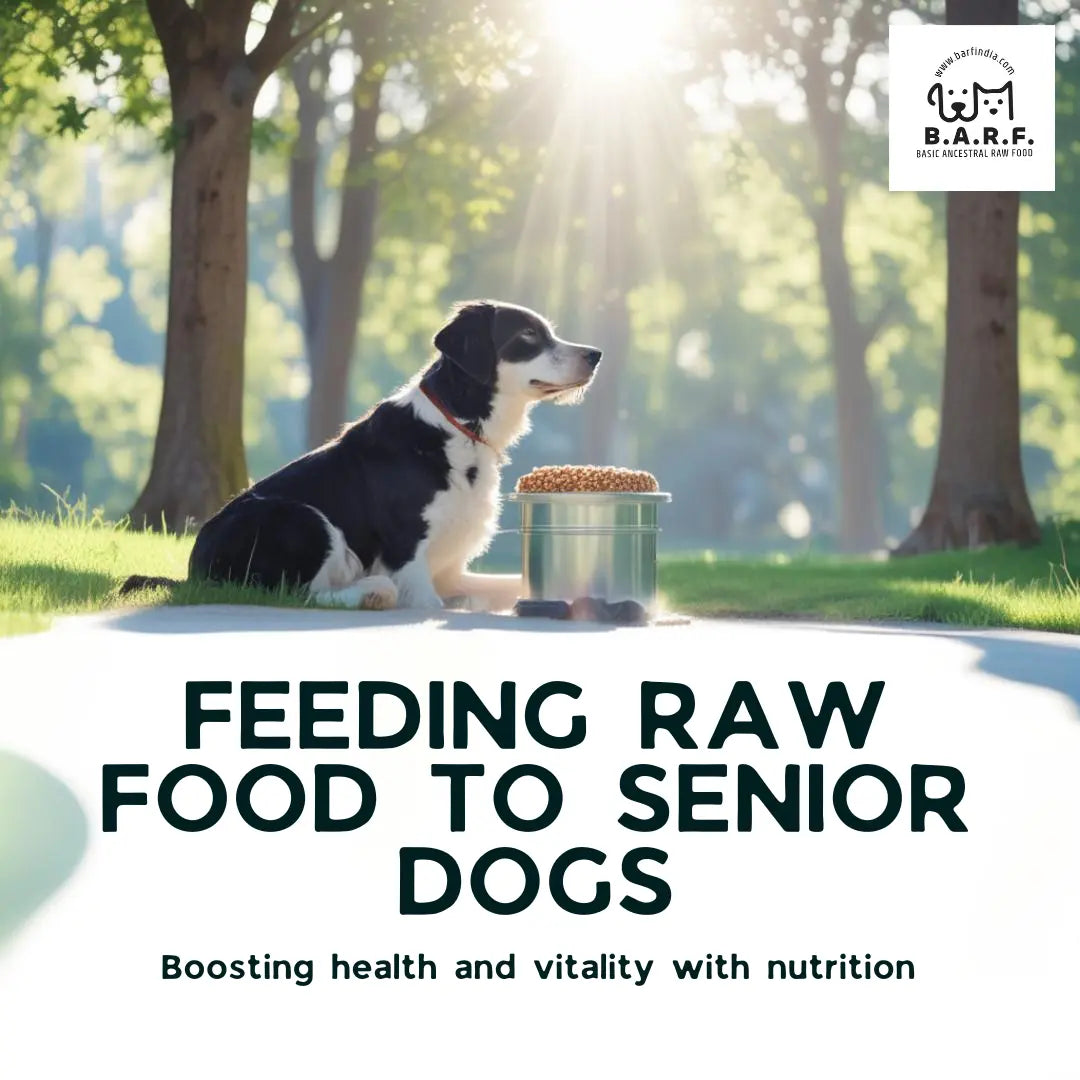
Can We Feed Raw Dog Food to a Senior Dog?
Nivedita FernandesSenior Dog Nutrition: Can We Feed Raw Dog Food Safely?
Introduction:
- Brief introduction to feeding raw dog food, specifically the BARF (Biologically Appropriate Raw Food) diet, to senior dogs.
- Mention the growing trend of switching to raw food for dogs of all ages, including senior dogs.
- Explanation of the purpose of the blog: to explore whether senior dogs can thrive on raw food and why the switch might be necessary.
1. Understanding the Senior Dog Diet:
- Definition of "senior dog" (typically around 7 years old and above, depending on the breed).
- Importance of a balanced diet for senior dogs and how their nutritional needs change with age.
- Common health issues in senior dogs (e.g., arthritis, weight gain, decreased metabolism, dental issues, digestive problems, and reduced energy).
- The need for more easily digestible, nutrient-dense food as dogs age.
2. What is BARF (Biologically Appropriate Raw Food) Diet?
- Introduction to the BARF diet and its principles: raw meat, bones, organs, and some plant matter.
- The philosophy behind raw feeding: mimicking a dog's natural diet, supporting their overall health, and meeting their evolving needs.
- The importance of providing a balanced and species-appropriate diet that meets a dog’s specific health needs.
3. Benefits of Feeding Raw Food to Senior Dogs:
A. Improved Digestion
- Raw food is easier to digest due to its natural enzymes, which are often destroyed during cooking.
- Senior dogs may suffer from digestive issues, and raw food can help alleviate bloating, constipation, or diarrhea.
- The BARF diet’s focus on natural, whole foods can support gut health and improve stool quality.
B. Joint Health & Inflammation Reduction
- Senior dogs often suffer from arthritis or other joint-related issues. Raw foods, especially those rich in omega-3 fatty acids (from fish), can help reduce inflammation.
- The inclusion of raw bones in the BARF diet helps keep joints lubricated and can provide natural sources of glucosamine and chondroitin.
C. Weight Management
- Raw food can help senior dogs maintain a healthy weight, which is critical for managing arthritis and heart conditions.
- The natural fats in raw food (like those found in BARF India’s products) help in regulating a senior dog’s metabolism.
- Less filler in raw food compared to processed kibble can prevent weight gain.
D. Skin and Coat Health
- Senior dogs often face skin problems, including dryness, itchiness, or hair thinning. A nutrient-rich diet like BARF food can lead to healthier skin and a shiny coat.
- Omega-3 and omega-6 fatty acids, present in fish and other raw food ingredients, are great for improving skin condition and reducing allergies.
E. Dental Health
- Raw food provides the necessary chewing action, which helps keep a senior dog's teeth clean.
- Bones in raw food act as a natural toothbrush, reducing tartar buildup and supporting oral health.
- This is particularly important for older dogs, who might suffer from dental decay or gum disease.
F. Increased Energy and Mental Sharpness
- With the right nutritional balance, senior dogs on a raw diet may experience improved energy levels and mental clarity.
- The amino acids in raw protein-rich foods are essential for maintaining healthy brain function in older dogs.
- Proper nutrition can help prevent cognitive dysfunction syndrome, commonly seen in senior dogs.
4. Is It Safe to Switch a Senior Dog to Raw Food?
- Concerns some dog owners might have when switching to raw food, especially with senior dogs.
- The importance of transitioning slowly to allow a dog’s digestive system to adjust.
- Potential risks and how to mitigate them: choking hazards, the need for appropriate balance of nutrients, and sourcing high-quality raw food.
- The role of BARF India in offering expertly formulated raw dog food for seniors, ensuring safety and quality.
5. Why the Switch to Raw Food Is Necessary for Senior Dog:
A. Aging and Reduced Nutrient Absorption
- As dogs age, their ability to absorb nutrients decreases. Raw food, being nutrient-dense and natural, ensures that senior dogs receive the right amount of vitamins, minerals, and proteins.
- The transition to raw food can help alleviate deficiencies that occur with commercial pet food.
B. Tailored Diet for Senior Health Issues
- Senior dogs are more prone to conditions like kidney disease, heart disease, arthritis, and obesity. A raw diet can be tailored to address these issues by providing easily digestible proteins, anti-inflammatory ingredients, and natural sources of antioxidants.
C. The Need for More Natural Foods
- Processed kibble is often packed with fillers, preservatives, and artificial ingredients, which can be difficult for senior dogs to digest.
- Senior dogs require a diet that is as close to their natural ancestral diet as possible. Raw food offers this with minimal processing, supporting overall health.
6.Concerns When Switching a Senior Dog to Raw Food:
A. The Risk of Bone Splinters and Choking
- While bones are an essential part of the BARF diet, they should be served correctly to avoid potential risks and that is to serve them raw and NEVER cooked.
- BARF India’s products are designed to ensure safety, offering ground bones or properly sized raw bones for senior dogs.
B. Balancing Nutrients
- Senior dogs need a balanced diet with the correct proportions of protein, fat, carbohydrates, vitamins, and minerals.
- BARF India provides specifically formulated raw meals to ensure that senior dogs get all the nutrients they need.
C. Price and Availability
- Raw food can sometimes be more expensive than kibble, but the long-term health benefits of raw food can save money on veterinary bills for senior dogs.
- BARF India offers cost-effective solutions and delivery options for ease of access.
7. How to Start Feeding Raw Food to a Senior Dog:
- Steps for transitioning a senior dog to a raw food diet: gradual introduction, monitoring, and ensuring the diet is properly balanced.
- Consulting with a veterinarian or pet nutritionist for specific dietary needs.
- Choosing the right products for senior dogs from BARF India, ensuring they get the most out of the diet.
8. Why BARF India Is the Best Choice for Your Senior Dog:
- Introduction to BARF India’s high-quality, balanced raw food designed specifically for the needs of senior dogs.
- Benefits of BARF India products: responsibly sourced ingredients, no fillers, preservatives, or artificial additives.
- How BARF India ensures a perfect balance of nutrients to support your senior dog’s health.
- Real-life testimonials from customers who have successfully switched their senior dogs to BARF India products.
- The company’s commitment to improving the overall health and longevity of dogs, particularly senior ones.
FAQs on Feeding Raw Dog Food to Senior Dogs
- Is it safe to feed raw food to my senior dog? Yes, feeding raw food to senior dogs is safe when done correctly. However, it’s important to transition them gradually and ensure their diet is well-balanced. BARF India provides specially formulated raw food for senior dogs to ensure they receive all the necessary nutrients without any health risks.
- What are the benefits of feeding raw food to senior dogs? Raw food offers several benefits for senior dogs, including improved digestion, joint health, better weight management, shinier coats, and increased energy. The raw, natural ingredients provide easily digestible nutrients and essential fatty acids that support overall health and well-being.
- Can raw food help my senior dog with arthritis or joint pain? Yes, raw food, particularly those rich in omega-3 fatty acids (like fish), can help reduce inflammation and alleviate joint pain, making it a great choice for dogs with arthritis. The bones in raw food also provide natural sources of glucosamine and chondroitin, which support joint health.
- How do I transition my senior dog to a raw food diet? Start by mixing a small amount of raw food with your dog’s regular food and gradually increase the proportion over 7-10 days. This will allow your dog’s digestive system to adjust. If you have any concerns or specific health needs, it’s always best to consult with a veterinarian.
- Are there any risks associated with feeding raw food to senior dogs? The main risks include choking on bones or an imbalanced diet. It’s crucial to feed appropriately sized bones and ensure the diet is nutritionally complete. BARF India offers ground bones and carefully balanced meals to mitigate these risks for senior dogs.
- How do I know if my senior dog is getting the right nutrients with raw food? BARF India’s raw food is specifically designed to meet the nutritional needs of senior dogs. Each meal is balanced with the right proportions of proteins, fats, and carbohydrates to support healthy aging. You can also work with a vet to monitor your dog’s health during the transition to raw food.
- Can I mix raw food with my senior dog’s regular food? Yes, you can mix raw food with your dog’s regular food during the transition period. However, it’s important not to mix raw food with kibble long-term as their digestion processes differ. Gradual transition to a fully raw diet is usually recommended for the best results.
- How much raw food should I feed my senior dog? The amount of raw food your senior dog needs will depend on their size, breed, activity level, and health conditions. As a general guideline, dogs typically require 2-3% of their body weight in raw food per day. BARF India offers portioning recommendations to help you determine the ideal feeding amount.
- What makes BARF India raw food ideal for senior dogs? BARF India’s raw food is formulated with high-quality, nutrient-dense ingredients to meet the unique dietary needs of senior dogs. The meals are carefully balanced, free from fillers, and packed with essential vitamins, minerals, and antioxidants to support aging dogs' health.
- Can raw food help with my senior dog’s dental health? Yes, raw food can promote better dental health in senior dogs. The chewing action required to eat raw food, especially bones, helps reduce tartar buildup and supports healthy teeth and gums. This is particularly important for older dogs, who are more prone to dental issues.
